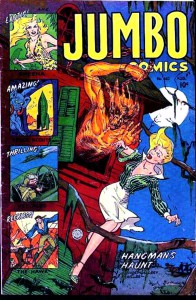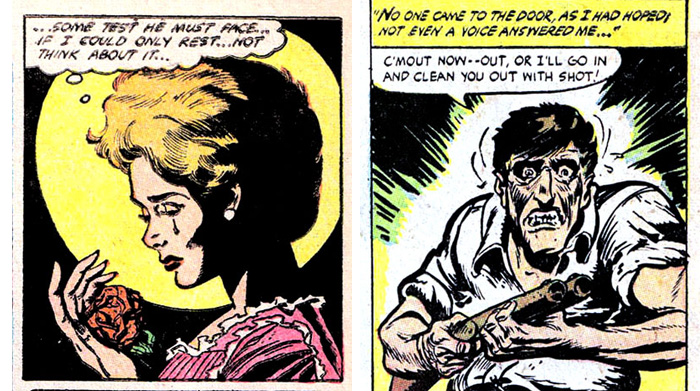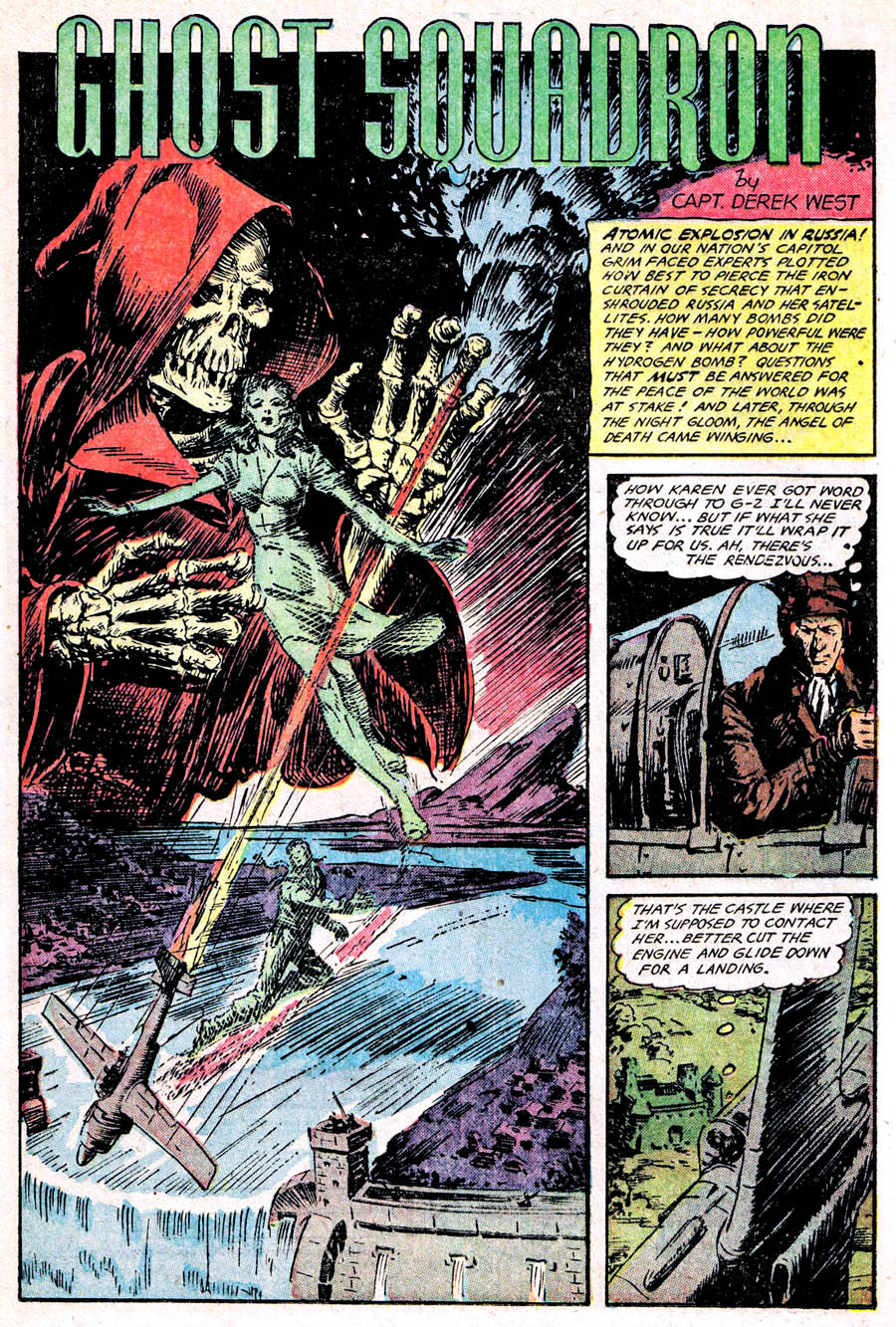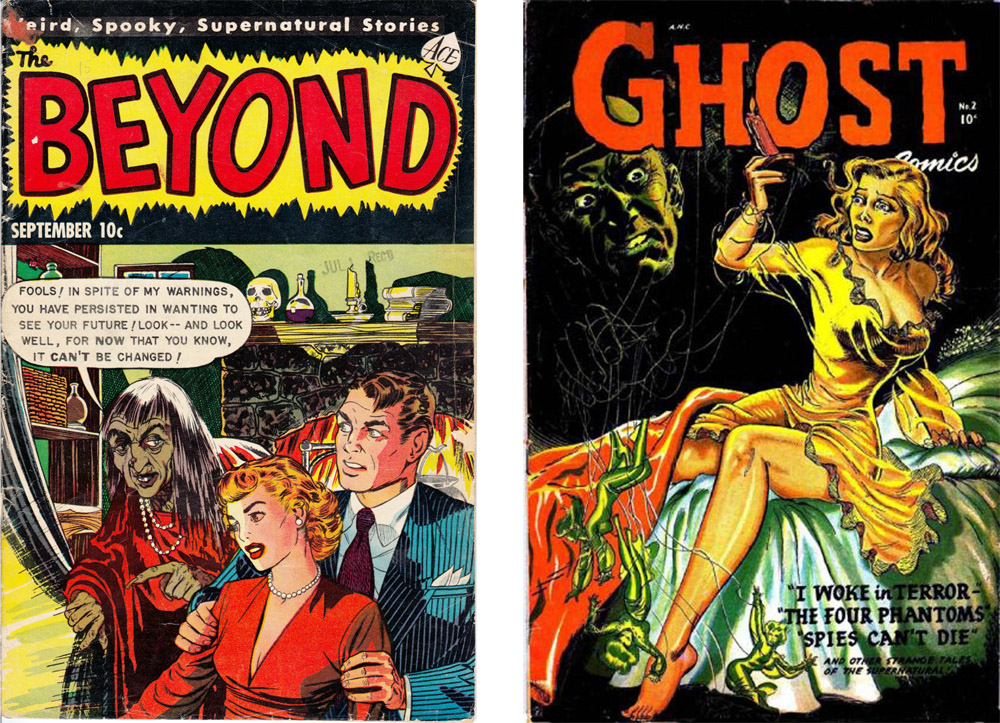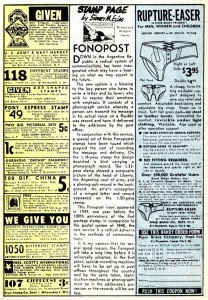This website takes an in-depth-look at the 44 horror comic books from Fiction House and Standard publishing companies.
Identifying artists, analyzing stories, hinting at nifty details, bespeaking points of interest, poking fun at inadaquacies and posting whole stories.
By the way: all the books are available to view and/or download at the Digital Comic Museum.
I took care of the last missing issues. So enjoy.
FICTION HOUSE HORROR !
“The Great Pre-Code Horror Swindle” could have been the overall title to Fiction House’s line of horror books. Yet after five issues of shameless 1940s reprints they made an effort and produced some all-new books as well.
Their output however remained a meager one. 13 books in total are only a footnote in horror history. But one can make fun discoveries everywhere. What we tried with FICTION HOUSE HORROR is to find where the reprints came from – and how they have been doctored to fit into the 1950s GHOST COMICS.
A word about Fiction House: founded in 1938 and closed down with the advent of the Comics Code in 1954, they published legendary books like FIGHT COMICS, JUMBO COMICS, JUNGLE COMICS, PLANET COMICS, RANGERS COMICS und WINGS COMICS.
They filled their books with Iger studio material and formed their own editorial staff at the same time. In the late 40s however they disbanded the artists’ bullpen again and continued to put out books with freelance contributions.
In the early 50s the company tried to maintain their publication schedule, but switched more and more to a merely quarterly publication rhythm. At the end of 1952 Fiction House started to thin out their line-up significantly.
But they held on to GHOST COMICS, for full 11 issues, starting at the end of 1951. Irritating though is their short intermezzo with MONSTER, the second horror title, which came out only twice. MONSTER – a title, by the way, which is just great for a horror book – and was never used before!
But let’s have a look at the artists – with emphasis on the young guns delivering fresh artwork.
Maurice Whitman
He never drew a single story for Fiction House horror, but those covers!
You can’t talk about Fiction House and not mention the covers. They CARED for covers. They knew what sold a comic book at the newsstands. Company president Thurman Scott supervised personally the design of every single cover (as an anecdote tells us in the delightful book “Comics Between The Panels”).
Fiction House covers are gorgeous.
Their use of color is only superseded by L. B. Cole’s wizardry at Star Publications. Vibrant title pages, often using a scantily clad “good girl” in the center. And that goes for the horror books as well! And Maurice Whitman did ALL of them.
Starting out in 1946 as regular artist for RANGERS, PLANET, JUNGLE and WINGS COMICS, Whitman was first assigned a cover in 1950 (WAMBI JUNGLE BOY #6). In 1951 followed LONG BOW INDIAN BOY and more jungle jobs with KAÄNGA and SHEENA.
Having dropped illustrating stories (mostly), Whitman was responsible for every Fiction House cover. From 1952 on his work graced also the title pages of FIGHT COMICS, JUNGLE COMICS, WINGS COMICS and INDIANS. He stayed the exclusive cover artist right up to the end.
Bill Benulis
Interesting young man, who worked only for Atlas/Marvel and Fiction House, starting out around 1952. Half of the time he used a steady inker for his pencilwork – Jack Abel. I saw the most extraordinary horror story by Benulis for STRANGE TALES #10 from Atlas. In “The Frightful Feet” he created a very weird animal kingdom that looked like Disney on LSD. Ever since I have been impressed with Benulis. Good man. Inventive.
It’s a downright shame that Benulis wasn’t around earlier. He would have added a lot to pre-code horror in general.
Jack Abel
In his early days Jack Abel was surely more able (sorry!) on inks than on pencils. At the end of 1956 he found a home at DC, drawing mostly war stories.
As I am no expert on Jack Abel, please have a look at him online – to see his impressive Wikipedia entry click HERE.
John Belcastro
Very minor artist who allegedly ran with the Iger Studio from 1952 to 1954. Worked almost exclusively for Fiction House. Grand Comics Database lists 39 spottings in total. Signed some of his jobs with “Johnny Bell”. Belcastro has a scratchy style which is actually quite likeable. Fits more than just decently into these horror comic books.
Albert, A.
No first name has ever surfaced with Mr. Albert. And he’s only credited with 21 jobs for Fiction House. Not a bad artist at all, mysterious Mr. Albert fits in nicely with colleagues Benulis, Bill Discount and this next one:
Bill Discount
And the next phantom pencil swinger, the third in a row. 34 spottings. He loved to swipe, mainly from Alex Toth. But again, like Albert and Belcastro, not a bad artist at all. His small oeuvre is limited to the years 1952-54 as well.
We post stories from all three in our “Stories” section – because they have earned it!
Alex Blum (reprinted)
I apologize for not appreciating this artist. Frankly, I hate that style of drawing. This is why I am into 1950s artwork.
Lily Renée (reprinted)
The same goes for one of the few women employed in the early comic book industry. Of course, 1940s artwork has its moments and some very creative page compositions now and then, but it’s soooooo bland in general. Sorry again.
Rafael Astarita (reprinted)
The exception to the rule: Now here’s a man who is obviously no comic book artist. This guy is an ILLUSTRATOR. Astarita puts glamour into a simple comic story. A veteran of the first hour (starting out with NEW COMICS #3 in February 1936!), Astarita landed at Fiction House in 1942 doing “Inspector Dayton” for JUMBO, “Hooks Devlin” for FIGHT and “Kaänga” for JUNGLE COMICS. Interesting to us is his stint on “Ghost Patrol/ Ghost Squadron” for WINGS.
Astarita’s goal was to put some art into comic book pages – and was a great inspiration to many fellow artists, among them George Evans and John Celardo.
The best comic book encyclopedia ever published (“Comics Between The Panels”) corrects me and points out that Astarita was the FIRST comic book artist to sign on with the FIRST comic book shop there ever was (Harry Chesler’s in 1935). That is just… Wow!
Jerry Grandenetti and/or Will Eisner
(or: “The Case of the Absent Artist”)
Fiction House ran a beautiful series called “The Secret Files Of Dr. Drew” in RANGERS COMICS. Three of these were reprinted in GHOST / MONSTER COMICS.
Comics history believes these to be the work of Jerry Grandenetti – because they were signed by him. This is a mysterious misguidance.
“Dr. Drew” was drawn by no one else than the great Will Eisner himself.
For further discussion and detailed information please look up our section “Art Spotting Controversy” in the menu bar – or just click HERE.
Fiction House artists’ “scoreboard”. Who did what and how much? General count, added together from both series and sorted by number of pages illustrated:
| John Belcastro | 56 | |
| Bill Benulis | 53 | (47 with Jack Abel on inks) |
| Alex Blum | 49 | (reprints) |
| A. Albert | 27 | |
| Will Eisner | 24 | (reprints) |
| Rafael Astarita | 24 | (reprints) |
| Jack Kamen | 22 | (reprints) |
| Bill Discount | 17 | |
| Lily Renée | 14 | (reprints) |
| Jack Abel | 11 |
Single story contributions by Art Peddy/Bernard Sachs, George Evans (rep.), Larry Woromay, Maurice Whitman (rep.), Charles Nicholas, Gus Schrotter (rep.) and Anthony D’Adamo.
Good to see that Fiction House horror can be linked to the names of three 1950s artists:
Bill Benulis, Jack Abel and John Belcastro.
Spotlight: The Covers
Fiction House sees no contradiction in blending horror with good girl art. Hey, that’s what they’ve been doing for years – why change a winning team and so forth, yadda yadda… Clearly an indicator, though, where they put their priorities.
We talked a bit about the outstanding covers above (see: Artists – Maurice Whitman), just let me elaborate some more in respect to the “eye candy” factor. A pubescent male teenager will automatically reach for a display of a damsel in distress. Is it fair that he may have been tricked into buying a bluff package?! The stories inside are reprints, often mutilated, the content is carelessly mashed together?! Of course it’s not fair!
But who could blame him? He could have gone for that horror book from Ace Magazines. Those with the excruciating balloons on the covers! Let’s make a test: You got 10 cent in your hands, buy a comic book please. Here’s your choice:
Quick! Choose! What will it be? Hmm?
The Ace book would have been the “sustainable” choice. Well-written, original art, but no babes. But all these are thoughts you develop decades after the buy.
A note on the margin: I find it highly irritating that so FEW companies employed continuously working cover artists. They missed the point of creating attention and recognizability of the product completely by randomly assigning whoever was free at the moment to do a cover.
They would not have gotten very far in modern marketing. Well, they didn’t get very far in the old marketing…
Fiction House Oddity: The Stamp Page
All the horror books I’ve encountered so far feature a text story without pictures (usually two pages long) – adding a non-comics shiver tale to their contents. Fiction House is different.
They give you as a text article the “Stamp Page”. Which is no page, but only the third of a page. It’s a text column squeezed between two advertising columns. That’s why I overlooked it first. But it’s there, issue for issue. A man called Sidney M. Elias enlightening you about the wondrous world of stamp collecting.
Fiction House used to sport two-page text stories (as a quick research into old 40s JUMBO COMICS reveals). The so-called “Stamp Page” replaced the text story sometime in 1951.
I don’t care for stamps, so I did not read it, but it seems they published the same article over and over again (not only one, mind you, but an assortment of stamp gems).
Just another sign that the company produced as effectively as possible; cost-effectively and reader-dontgiveadamnedly. I made that word up, so what?
Appendix: Fiction House Chronology 1951-1954
To give you an overview of the company’s output, here’s a listing of all their comic books from beginning of 1951 to the end of 1954.
Left column: horror books – Right column: every other comic book published in these years.
Timetable looks a bit chaotic, because publication is sometimes noted only per year, sometimes per quarter, sometimes per month.
| 1951 | ||
| Sometime 1951 | PLANET COMICS #65 (only issue in 1951) APACHE (one-shot) |
|
| January 1951 | ||
| JUNGLE COMICS #133 JUMBO COMICS #143 FIGHT COMICS #72 |
||
| February 1951 | ||
| JUNGLE COMICS #134 JUMBO COMICS #144 RANGERS COMICS #57 |
||
| March 1951 | ||
| JUNGLE COMICS #135 JUMBO COMICS #145 FIGHT COMICS #73 |
||
| April 1951 | ||
| JUNGLE COMICS #136 JUMBO COMICS #146 RANGERS COMICS #58 INDIANS #5 |
||
| Spring 1951 | ||
| WINGS COMICS #113 FIREHAIR #7 COWGIRL ROMANCES #5 LONG BOW, INDIAN BOY #2 WAMBI, JUNGLE BOY #11 SHEENA, QUEEN OF THE JUNGLE #11 KAÄNGA COMICS #7 |
||
| May 1951 | ||
| JUNGLE COMICS #137 JUMBO COMICS #147 FIGHT COMICS #74 |
||
| Summer 1951 | ||
| WINGS COMICS #114 FIREHAIR #8 COWGIRL ROMANCES #6 LONG BOW, INDIAN BOY #3 WAMBI, JUNGLE BOY #12 SHEENA, QUEEN OF THE JUNGLE #12 KAÄNGA COMICS #8 |
||
| June 1951 | ||
| JUNGLE COMICS #138 JUMBO COMICS #148 RANGERS COMICS #59 INDIANS #6 |
||
| July 1951 | ||
| JUNGLE COMICS #139 JUMBO COMICS #149 FIGHT COMICS #75 |
||
| August 1951 | ||
| JUNGLE COMICS #140 JUMBO COMICS #150 RANGERS COMICS #60 INDIANS #7 |
||
| September 1951 | ||
| JUNGLE COMICS #141 JUMBO COMICS #151 FIGHT COMICS #76 |
||
| Fall 1951 | ||
| FIREHAIR #9 COWGIRL ROMANCES #7 LONG BOW, INDIAN BOY #4 WAMBI, JUNGLE BOY #13 SHEENA, QUEEN OF THE JUNGLE #13 KAÄNGA COMICS #9 |
||
| October 1951 | ||
| JUNGLE COMICS #142 JUMBO COMICS #152 RANGERS COMICS #61 INDIANS #8 |
||
| November 1951 | ||
| JUNGLE COMICS #143 JUMBO COMICS #153 FIGHT COMICS #77 |
||
| December 1951 | ||
| JUNGLE COMICS #144 JUMBO COMICS #154 RANGERS COMICS #62 INDIANS #9 |
||
| Winter 1951 | ||
| GHOST COMICS #1 | WINGS COMICS #115 FIREHAIR #10 COWGIRL ROMANCES #8 LONG BOW, INDIAN BOY #5 WAMBI, JUNGLE BOY #14 SHEENA, QUEEN OF THE JUNGLE #14 KAÄNGA COMICS #10 |
|
| January 1952 | ||
| JUNGLE COMICS #145 JUMBO COMICS #155 FIGHT COMICS #78 |
||
| February 1952 | JUNGLE COMICS #146 JUMBO COMICS #156 RANGERS COMICS #63 INDIANS #10 |
|
| March 1952 | ||
| JUNGLE COMICS #147 JUMBO COMICS #157 FIGHT COMICS #79 |
||
| April 1952 | ||
| JUNGLE COMICS #148 JUMBO COMICS #158 RANGERS COMICS #64 INDIANS #11 |
||
| Spring 1952 | ||
| GHOST COMICS #2 | FIREHAIR #11 (last) COWGIRL ROMANCES #9 KAÄNGA COMICS #11 WAMBI, JUNGLE BOY #15 SHEENA, QUEEN OF THE JUNGLE #15 PLANET COMICS #66 WAR BIRDS #1 THE SPIRIT #1 LONG BOW, INDIAN BOY #6 |
|
| May 1952 | ||
| JUNGLE COMICS #149 JUMBO COMICS #159 FIGHT COMICS #80 |
||
| June 1952 | ||
| JUNGLE COMICS #150 JUMBO COMICS #160 RANGERS COMICS #65 (last) – will be resurrected as RANGERS (see below) INDIANS #12 |
||
| GHOST COMICS #3 | Summer 1952 | WINGS COMICS #116 COWGIRL ROMANCES #10 KAÄNGA COMICS #12 WAMBI, JUNGLE BOY #16 SHEENA, QUEEN OF THE JUNGLE #16 PLANET COMICS #67 WAR BIRDS #2 THE SPIRIT #2 LONG BOW, INDIAN BOY #7 JET ACES #1 (first) |
| July 1952 | ||
| JUNGLE COMICS #151 JUMBO COMICS #161 FIGHT COMICS #81 |
||
| August 1952 | ||
| JUNGLE COMICS #152 JUMBO COMICS #162 INDIANS #13 RANGERS #66 (first) – the second installment |
||
| September 1952 | ||
| JUNGLE COMICS #153 JUMBO COMICS #163 FIGHT COMICS #82 |
||
| Fall 1952 | ||
| GHOST COMICS #4 | COWGIRL ROMANCES #11 WINGS COMICS #117 KAÄNGA COMICS #13 WAMBI, JUNGLE BOY #17 SHEENA, QUEEN OF THE JUNGLE #17 PLANET COMICS #68 JET ACES #2 INDIANS #15 RANGERS #68 LONG BOW, INDIAN BOY #8 |
|
| October 1952 | ||
| JUNGLE COMICS #154 JUMBO COMICS #164 INDIANS #14 RANGERS #67 |
||
| November 1952 | ||
| JUNGLE COMICS #155 FIGHT COMICS #83 |
||
| December 1952 | ||
| JUNGLE COMICS #156 JUMBO COMICS #165 |
||
| Winter 1952 | ||
| GHOST COMICS #5 | FIGHT COMICS #84 WINGS COMICS #118 KAÄNGA COMICS #14 WAMBI, JUNGLE BOY #18 (last) SHEENA, QUEEN OF THE JUNGLE #18 (last) PLANET COMICS #69 JET ACES #3 THE SPIRIT #3 COWGIRL ROMANCES #12 (last) INDIANS #16 LONG BOW, INDIAN BOY #9 (last) |
|
| 1953 | ||
| Sometime 1953 | 3-D-FIRST CHRISTMAS (one-shot) 3-D-CIRCUS (one-shot) 3-D-SHEENA, JUNGLE QUEEN (one-shot) MAN O’ MARS #1 (one-shot) THE SPIRIT #4 |
|
| February 1953 | ||
| JUMBO COMICS #166 | ||
| March 1953 | ||
| JUMBO COMICS #167 (last) | ||
| April 1953 | ||
| JUNGLE COMICS #157 | ||
| Spring 1953 | ||
| GHOST COMICS #6 | JUNGLE COMICS #158 WINGS COMICS #119 KAÄNGA COMICS #15 PLANET COMICS #70 FIGHT COMICS #85 JET ACES #4 (last) INDIANS #17 (last) |
|
| Summer 1953 | ||
| GHOST COMICS #7 MONSTER #1 |
JUNGLE COMICS #159 WINGS COMICS #120 KAÄNGA COMICS #16PLANET COMICS #71 |
|
| Fall 1953 | ||
| GHOST COMICS #8 MONSTER #2 (last) |
JUNGLE COMICS #160 WINGS COMICS #121 KAÄNGA COMICS #17 PLANET COMICS #72 |
|
| Winter 1953 | ||
| GHOST COMICS #9 | JUNGLE COMICS #161 WINGS COMICS #122 KAÄNGA COMICS #18 RANGERS #69 (last) WAR BIRDS #3 (last) PLANET COMICS #73 (last) KNOCKOUT ADVENTURES #1 (one-shot) |
|
| 1954Sometime in 1954 | ||
| THE SPIRIT #5 (last) | ||
| January 1954 | ||
| FIGHT COMICS #86 (last) | ||
| Spring 1954 | ||
| GHOST COMICS #10 | JUNGLE COMICS #162 WINGS COMICS #123 KAÄNGA COMICS #19 |
|
| Summer 1954 | ||
| GHOST COMICS #11 (last) | JUNGLE COMICS #163 (last) WINGS COMICS #124 (last) KAÄNGA COMICS #20 (last) |
Both issues of MONSTER have been published sometime in 1953, our placing them in summer and autumn is speculative.
Oddity in publication schedule for INDIANS which shows a bi-monthly rhythm in 1952. There’s INDIANS #13 in August, INDIANS #14 in October – and INDIANS #15 in “Fall 1952”. Then INDIANS #16 is labeled “Winter 1952”. So where exactly does #15 come out? In November (which would go against the bi-monthly schedule)? In December? Might be, but is that “Fall” anymore? And winter is pressing with its # 16…
So you’ll find a strange occurrence in my listing: INDIANS #15 comes out before INDIANS #14. Just to let you know I do not approve of Fiction House’s way of indicating their dates of publication. A similar case is RANGERS #67 / #68…
About Fiction House’s horror books – it’s a clear picture:
First they want to cash in on the horror boom and put out old material wrapped in fresh pell-mell covers. Then they start giving a damn in mid-1953 and produce original art, but with the advent of the year 1954 the show is closing down.
Fiction House has already canceled their flagship title JUMBO COMICS and tries to hold on to JUNGLE, WINGS, KAÄNGA and PLANET. And GHOST COMICS as well!
They seem to set high hopes in horror, but all is lost in summer 1954 – and all titles get axed.


